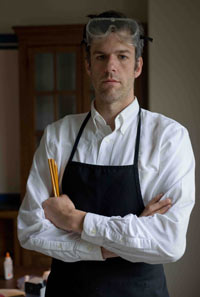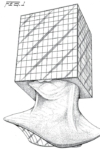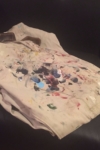Over the past few years, David Rees has been mastering the art of pencil sharpening, whether it be with a knife, a double-blade pocket sharpener, or an antique double-burr hand cranked sharpener. His new book, How To Sharpen Pencils, is a how-to guide to the artisanal practice. Demonstrating the different types of pencil points, the importance of the proper sharpening etiquette (to avoid injury), and even how to sharpen a pencil with your mind, Rees’ guide is an inclusive and enlightening entry into the intricate world of pencils. A world which, now far removed from elementary school, we might have forgotten.
Rees is perhaps most well-known for his political cartoon strip Get Your War On, which gave us frank, brutal, and hilariously bleak strips comprised of clip art, and emerged shortly after the 9/11 attacks to form one of the first true leftist critiques of the Bush administration at war.
Full Stop spoke with David Rees about the betrayal of the electric sharpener, the organic lifestyle, and pencil sharpening as politik.
When did you first get involved with pencil sharpening?
Initially, just as a kid. Like everybody else. I got back into it — started thinking about it more clinically — a couple of years ago. I had a job working for the United States census bureau because I quit being a political cartoonist. I got a job knocking on doors. On the first day of staff training, they gave us these bags that had all the supplies we would need for our job. And inside the bag there were some pencils and a single blade pocket pencil sharpener. On the first day of staff training, the trainer said, “Okay, now, according to our schedule, everyone needs to sharpen their pencils.” So we all just stood around sharpening these pencils. It was like this weird, state-mandated moment of whimsy. I really hadn’t sharpened a pencil in a long time, and I thought, “This is really satisfying. This is probably more fun than working for the census. I’m going to figure out how to get paid to do this; to just sharpen pencils.” So that’s when I started the business, and started the website, and did all that.
How did you go about starting your business?
There was a lot of research and development that went into it, and a fair amount of investment. I had a lot of decisions to make: how much would I spend up-front on pencil sharpeners? How much I should spend on pencils? [Would I] need to buy pencils, or would people just be mailing in their pencils? That was the original business model, where people mailed pencils in, but it didn’t really work. The biggest thing was how would I ship a sharpened pencil through the mail without it breaking? That involved the most work. I knew I would have to break that down into two discreet stages: the first was going to be protecting the tip on the pencil, and the second was protecting the wooden shaft of the pencil. I took a sharpened pencil to a hardware store, because I thought flexible tubing of some sort would be a good idea. I just shoved the pencil into all these different rubber hoses until I found the one that worked. Once I had the rubber sheath on the tip, you put the whole thing in a large rubber tube, and that’s what keep the body from breaking in the mail. Because the few times that people have sent pencils to me, they have arrived broken or fucked up. One guy just sent a No. 2 pencil to me in an envelope and I just got an empty envelope with a big hole in it.
Is that the fault of the postal service?
I don’t want to assign blame. Somebody didn’t think it through. Let’s just say that. But I did, fortunately. So that took a while — figuring that stuff out, pricing it, figuring out suppliers for all these things that I would need. And then my friend Mike, who is a printmaker in Brooklyn, made me a promotional poster. It took a while to get it started, to get it ramped up. But once it started, it was more successful than I thought it was going to be.
When it comes down to it, what is your favorite method of sharpening? Knife?
I don’t have a favorite. My favorite is the one that satisfies the client’s needs. These days, I’ve been really into using a pocket-knife or a box-cutter, but other times I go through periods where I really want to nail the single-blade pocket-sharpener. It’s the simplest, but it can really fuck up a pencil point. You get a new tool and then you get really, really into that tool. I got a reproduction of a 1910 pencil sharpener.
The El Casco?
No, the El Casco is contemporary. I went to this antique store in Vermont where this guy specialized in antique office supplies. It’s called the Little Shaver. It’s a razor blade on a little arm, and you stroke it along the shaft of the pencil. I used one in Vermont for a photo shoot, and a Canadian hardware company started making a remake of it, and they sent me one.
How did people in your life react when you stepped away from political cartooning and took up the pencil?
I can answer that in one little vignette: I was on the way home to North Carolina to visit my parents the day that the Los Angeles Times published an article about artisanal pencil sharpening, and the comments were completely bewildered and enraged. And people were making arguments for dismantling the welfare state, the argument being, If we kick everyone off welfare, everyone will become an entrepreneur, like this guy. And there’s other people saying, This proves America is doomed. Bankers are so rich, they’re paying for people to sharpen pencils for them.
So I went home to North Carolina, and my parents knew about this thing, but they were still a little confused about it. I told my mom that she should read the LA Times article and took a nap. When I woke up, she was stroking my hair and said, “You need to go back to political cartooning.” Ironically, people used to get really enraged on the internet about my comics, which I get. It was about politics and the war on terror and stuff. I didn’t think fucking sharpening pencils would make people just as mad, you know what I mean? But that’s the glory of the internet. Pick your poison, people will get mad about it. So that was kind of crazy. I’ve never had anyone come up to me at a live pencil event and rage at me.
Do you view pencil sharpening as a political act?
No. To me, the great thing about this project is that there’s no political subtext to it. It doesn’t have anything to do with human rights abuses, or the War on Terror, or extraordinary rendition, or illegal wiretapping — that was the last seven years of my life. This is just something that’s fun, makes people happy, is supposed to be satisfying and is now kind of like this challenge: how far can I take this project of sharpening pencils?
Where do you find the customers?
The clientele is a mix. The book opens with testimonials from people from all different professions. It’s a lot of testimonials from writers and artists, it’s a lot of schoolteachers, or people buying lucky pencils for their kids, for something like a standardized exam. A lot of people order them as gifts; one guy got it for his wife as a wedding present. So I think a lot of people see it less as an actual functional pencil that they’re going to use, and more as a symbol of the past, or symbolic of doing a good, honest day’s work. Or just an aesthetic ideal of the yellow No. 2 pencil. The client base seems pretty broad in terms of profession.
There’s a lot of poetry in this book — Gerard Manley Hopkins, a few others. Do you feel that pencils are very much associated with the act of writing, easily lending themselves to poetry?
I don’t know if it’s that so much as that this book was inspired by a very particular type of literature, which was early and mid-century how-to literature. And I collect those types of books. A lot of times, the language in those volumes — even if it’s about machine tool upkeep or the shipfitters manual that I based this book on — the language is very inspirational and literary and gentlemanly. And I really wanted to try to apply that language to something that is very familiar to all of us, which is sharpening pencils. To make a familiar thing unfamiliar; to make it new again; to see it in a new way so you can see how badass it is and how badass pencils are. And so, to that end, I felt like quoting poetry was very appropriate. I wanted it to have this dream-like quality referring to the outside world, but referring to it in an edifying way. Edifying is the word I keep coming back to.
I dedicated the book to my parents, and Gerard Manley Hopkins is one of my dad’s favorite poets. And he used to recite him at dinner. One of my earliest memories of a pencil is a picture of a car as a pencil that my dad drew for me as a kid. So there’s this nostalgia for my own childhood and my own family, and that goes along with the nostalgia for pencils.
People tend to see things termed “artisanal” through the lens of nostalgia. Are artisanal works only important because they are obsolete?
I think people sometimes fetishize that movement. I think, for a lot of products, there’s a reason that modern industrialization was the way to go: because it’s better and easier. Obviously, you’re talking some generic bland pickle versus some kickass organic pickle [made] from cucumbers that were grown in somebody’s garden. I wouldn’t pay a premium for that, because I don’t like pickles. But I get it; I totally get it. People make fun of people for spending a lot of money on bacon at farmer’s markets, but I’d rather go to that then a fucking Knicks game or something. So I don’t have strong opinions of it one way or another. When I called my business artisanal pencil sharpening, that was based on marketing for where I live, which is the Hudson Valley; which has a lot of farmers markets. My friends have a wine shop called Artisan Wine Shop — there’s artisan this, artisan that. I felt like that’s the phenomenon I should be associated with.
You fit right in with this throwback to the Hudson Valley’s more industrial days.
The Hudson Valley did have all this industry, and the sad fact is that all of it is now gone. The town I live in, Beacon, has tons of abandoned factories. Parallel to that, there’s a lot of farmland up there, so you’re going to get people who are interested in sustainable farming or small-scale agriculture, which means they’re probably going to make good pickles. That kind of stuff. They’re going to have farm-raised beef. I feel more connected to it outside of the city than inside, because you see more of the production end of things then the consumption end of it.
In Get Your War On, you use clip art, which was a sort of staple of our collective childhoods during the early days of the word processor and internet. With pencils, you’re also accessing our childhood. What draws you to these objects from childhood?
Maybe it’s because I feel intimidated by new technology and by the future, and by adulthood and maturity. I’m constantly looking into the past — tools from the past, half-remembered phenomena from the past — and yanking it with me to express my current condition. Maybe that’s why I got interested in pencils. I feel more comfortable with old things than new things. One time I heard an interview with Billy Bob Thornton where he talked about how freaked out he got by old furniture; just couldn’t be around old furniture. I have the opposite. I get freaked out sometimes by new furniture, or, like, new things. I love old, stinky, musty shit. If I go into a new bookstore, and see all the new books, I get really anxious. I know I’m contributing to the problem with this book. But it’s, like, Man, fucking books! We haven’t even finished reading the old stuff. I feel that way about a lot of stuff. Maybe it’s just a problem I have.
There’s a very fraternal tone in your book, that’s very warm and inviting. The same tone is present in the how-to books you mentioned. Did writing about something you’re passionate about lend something to the tone of the book?
I wanted to do two things at the same time: I wanted to teach people how to sharpen pencils using different techniques (it’s not just a joke. It’s not a fake pencil-sharpening manual. It’s not a parody. It is a literal fucking pencil sharpening manual. It does what it says on the box), but I also didn’t want to write a completely dry or completely straight manual that you would buy at a Home Depot. I didn’t want it to be purely utilitarian or instrumentalist. I wanted it to be fun to read, as an homage to all these old how-to manuals that I’ve been collecting for the past few years, but [I also wanted] to try to write in that colloquial voice. It was cool to try to couple those two impulses to write what I hope is interesting language, but also to convey actual real information. To make sure that if you follow the instructions, you succeed at the task at hand. It’s a little challenge that I set for myself. You come up with these limits and then you do as much as you can within these rules and limits — like making a cartoon that uses only five pieces of clip-art, or something. It gets me excited to establish boundaries for what I’m trying to do.
Why do you think people find your career as a pencil sharpener even more controversial than your incendiary political cartoons?
Part of that is the context. When I started Get Your War On, there wasn’t much anti-Bush satire yet. I started it four weeks after 9/11; it was pretty early out of the gate. I got worse feedback from that than the pencil sharpening thing. It’s just that over the years, as the tone of political satire changed, Get Your War On became less and less extraordinary. There were other outlets for people to read or create content, so I stopped getting as much negative content. Which was fine, because I found it kind of stressful and exhausting. The LA Times stuff was really nostalgic. I was like, Man, people really fucking hate me again.
When I’m at a party and people ask me, “What do you do?” (And, frankly, this isn’t my job. I can’t make a living doing it. It’s a lucrative hobby.) But when people ask me what I do, I say, “I have a lucrative pencil-sharpening business.” They’re usually just confused. They ask what I mean. And then I explain it and they either have a lot of questions or a lot of memories about when their grandfather showed them how to sharpen a pencil with a penknife, or we talk about something else.
What’s been your worst pencil sharpening injury?
The only time I injured myself badly was when I was doing research and development — testing different types of tubing; testing a particular type of tubing. And I was cutting tubing with scissors instead of using a box-cutter, which is what I would normally use, and I cut into the webbing between my fingers. And that was the first night I was trying things out, and I was like, This business is going to cost me my life. But fortunately, that’s been the only real injury I’ve had.
The first part of the book is very instructional; the second part of the book goes to some different places.
I wrote the later chapters first, because I was really intimidated to write the really basic pencil-sharpening chapters. I knew that I wanted to have something about electric pencil sharpeners, and I wanted it to be that you just destroy them — that’s how you use [them]. And I wanted to do some celebrity-impersonation pencil-sharpening, because that’s a pretty fun and cool idea. I knew I wanted to do something on sharpening pencils with your mind. Writing those chapters was really exciting, because you’re still writing in the voice of a how-to manual, but you’re trying to address some deeper stuff — the idea of working within the form, but doing something that the form doesn’t usually permit.
What does it say about a person if they use an electric pencil sharpener?
That’s a person who has decided not to think about that aspect of their life. You use it because you don’t want to think about sharpening pencils, and you don’t want to sharpen pencils. There’s probably stuff I do in my life that would offend people who are enthusiasts for that particular product. Truth be told, I don’t make my own granola. I just go out and buy some fucking granola. And there’s probably people out there who are like, What a waste. Here’s a guy who just wants to shove granola into his mouth, with minimal effort — doesn’t even know how great granola can be. Everyone has to pick their indulgences, especially when time is at a premium.
The ironic thing is, that time is how the early pencil sharpeners were marketed. I’m not even talking about electric pencil sharpeners; I’m talking about mechanical pencil sharpeners. They were pitched to the bosses: think of how much time is wasted by the men in your office as they labor to sharpen their pencils with penknives. Why they have to do it three times a day. And it takes three minutes. That’s ten minutes! This device will point a pencil in a matter of seconds. And you look at the funny ads and think it’s some really effective pencil sharpener, but it’s just some crazy-ass Rube Goldberg thing from 1895. The electric pencil sharpener is a further iteration of these ideas, so I thought it would be funny to smash one with a hammer.
You describe how different types of sharpened pencils are for different types of individuals. Are those lines solid?
They’re definitely suggested uses. One of the things I learned by sharpening pencils is that when you look at a pencil point, you usually are looking at a pretty standard image. But there’s a lot of variety, even in that severely restricted space, for the severely restricted engineered realities of the typical No. 2 pencil. You can produce different points, and they can be used for different things. Like, if you wanted to run your pencil along a straight edge ruler, you almost don’t even want a straight point. You want a flat edge. That’s one variety right there that really made a difference. It’s really just about suggested uses. This book only deals with No. 2 pencils, however. The conversation becomes much broader if you start talking about other pencils.
Have you worked with other pencils?
Every so often, but I only ship out No. 2 pencils for my business, because I just want the business to focus on the nostalgic No. 2 pencil that we remember from our childhoods.
Do you always associate the No. 2 pencils with good memories? I feel like I associate it with standardized testing, which isn’t a good memory.
It’s a complicated relationship. I definitely have some anxiety related to it, also having to do with standardized tests. It’s funny that I came back to them through the census, because the whole reason we were sharpening pencils was because the census was done through Scantron sheets. You fill them out with a No. 2 pencil just like the SAT; just like all those horrible tests. That’s why I feel a twinge of melancholy whenever I get a request to sharpen for a kid about to take the SAT: better make sure this one is extra badass.
Do you always want to know the desired use of the pencil as you make it?
I do if I’m doing a live event. I ask people what they’re going to use it for, definitely. But most people, when they order through the mail, I don’t know. Sometimes people will attach a note, like, This is for my friend, he’s a writer. A lot of times when they don’t attach a note, I just send them a really sharp pencil. And I assume that they’ll keep it in a display.
You sharpen in public?
I’ve done it at parties, at art openings, on a cruise ship, at a rock concert, just for friend sitting around having a drink. I’ve done it in a waterfall, at a comedy show, in an abandoned factory. I like it.
This post may contain affiliate links.








